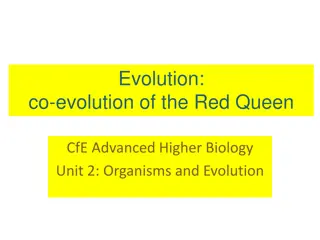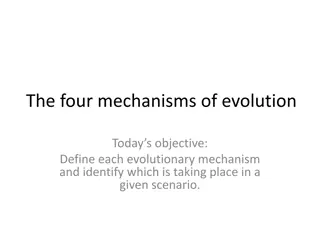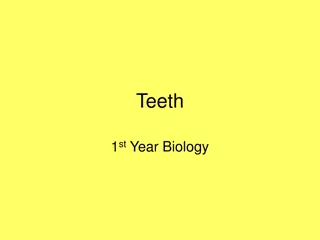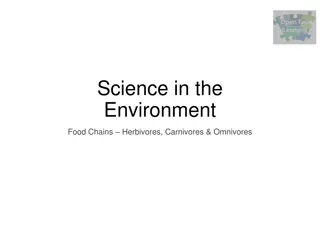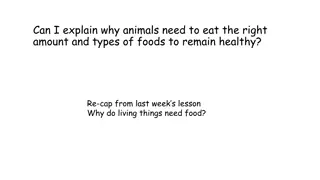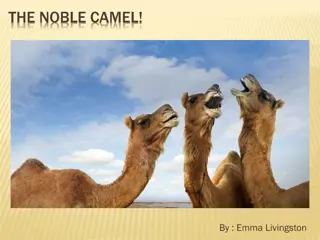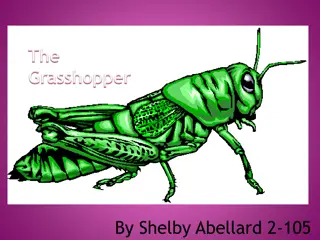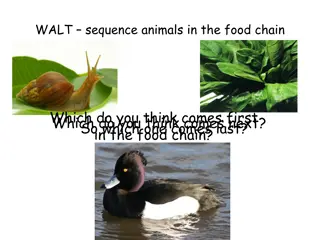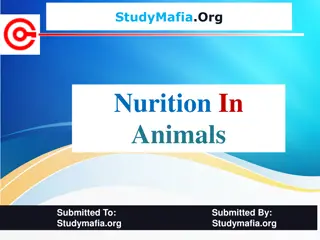Understanding Ecological Relationships and Food Chains
Explore the intricate ecological relationships in nature, including population dynamics, producer-consumer systems, and different types of consumers like herbivores, carnivores, and decomposers. Learn about food chains, food webs, and the interconnectedness of organisms in ecosystems through informa
0 views • 38 slides
Tracing Carbon Atoms in Ecosystems: Understanding the Organic Matter Pyramid
Explore the journey of 500 carbon atoms through producers, herbivores, and carnivores in an ecosystem. Discover how carbon atoms move through photosynthesis, cellular respiration, and biosynthesis, ultimately contributing to the organic matter pyramid. Follow the pathways of carbon atoms as they cyc
0 views • 7 slides
Explore the Fascinating World of Habitats and Organisms in Habitat Jeopardy!
Dive into the diverse habitats and learn about living and non-living organisms with Habitat Jeopardy! Explore the characteristics of habitats like temperate forests, wetlands, and freshwater habitats. Discover the natural homes of animals, plants, and more, while testing your knowledge with exciting
0 views • 45 slides
Understanding Energy Flow in Ecosystems
Energy flow in ecosystems is vital for sustaining life as it moves through different trophic levels. Primary producers harness solar energy to create organic material, which is then consumed by herbivores, carnivores, and decomposers, forming intricate food chains. Terms like biomass, productivity,
0 views • 8 slides
Understanding Ecosystems: A Beginner's Guide to Ecology
Explore the fascinating world of ecosystems with Mrs. Hart in this informative biology lesson. Discover the components of ecosystems, from biotic to abiotic factors. Learn how energy flows through the ecosystem, with autotrophs producing energy and heterotrophs consuming it. Identify different types
0 views • 33 slides
Understanding Animal Communities in Geography
Animal communities are formed by various species occupying the same habitat or microhabitat, interacting within a biological community. Each species has a unique ecological niche, influencing interactions like competition and predation. Communities consist of producers, herbivores, carnivores, and m
1 views • 9 slides
Understanding Sarcocystis Parasites in Veterinary Parasitology
Veterinary Parasitology delves into the study of Sarcocystis parasites, focusing on their morphology, life cycle, and impact on hosts. The Sarcocystidae family, including species like Sarcocystis hominis and S. suihominis, are examined for their pathogenicity in carnivores and herbivores, shedding l
1 views • 11 slides
Exploring Community Ecology: Interactions in Ecosystems
Community ecology, as presented by Mr. Nitin A. Ghorpade, delves into the dynamics of species interactions within ecosystems. It covers concepts like communities, individualistic vs. interactive hypotheses, interspecific interactions, predation, parasitism, plant defenses against herbivores, and mor
0 views • 23 slides
Exploring Various Ecosystems Through Food Webs
Delve into the intricate relationships between organisms in different ecosystems through visually captivating food web illustrations. From the Antarctic to boreal forests, grasslands, deserts, and marine environments, witness the complex interactions between producers, herbivores, carnivores, and mo
0 views • 15 slides
Test Your Knowledge with Food Web and Food Chains Quiz
Explore the fascinating world of food chains and webs through this interactive quiz. Test your understanding of consumers, producers, predators, prey, herbivores, carnivores, and more. Challenge yourself to identify different roles in ecosystems and how organisms depend on each other for survival.
0 views • 22 slides
Understanding Co-evolution: A Closer Look at the Red Queen Hypothesis in Biology
Co-evolution refers to the reciprocal genetic changes in species in response to each other. The Red Queen Hypothesis, illustrated in the arms race between parasites and hosts, exemplifies this phenomenon. This interaction drives evolutionary dynamics in herbivores, plants, pollinators, prey, predato
0 views • 18 slides
Understanding Leaf Anatomy: Bud Scales to Leaf Apex Shapes
The article delves into the intricate structures of plant leaves, from bud scales that protect vegetative buds to sharp spines guarding against herbivores. It explains the leaf blade's composition, detailing the mid-rib, veins, margin, and apex. Various leaf apex shapes are explored, including obtus
0 views • 242 slides
Understanding Evolutionary Mechanisms in Pepper Populations
Explore the evolutionary mechanisms of natural selection and genetic drift through a fun activity involving a wild chili pepper population. Witness how chemical defense affects the survival and reproduction of pepper plants against herbivores and pathogens. Learn about the concepts of mutation, gene
0 views • 23 slides
Understanding Teeth: Types and Functions in Biology
Explore the world of teeth in biology, including the four different types of teeth - incisors, canines, premolars, and molars - each with unique functions for cutting, tearing, crushing, and grinding food. Discover how different animals have varied sets of teeth depending on their diet, distinguishi
0 views • 15 slides
Understanding Animal Diets: Herbivores, Carnivores, and Omnivores
Explore the world of animal diets by learning about herbivores, carnivores, and omnivores. Discover what different animals eat and the classifications based on their diet preferences. Engage in activities to distinguish between herbivores, carnivores, and omnivores, and understand the special charac
0 views • 14 slides
Understanding Animal Dietary Needs for Health
Animals require the right amount and types of foods to stay healthy. Different animal species have specific diets - herbivores eat plants, carnivores consume meat, and omnivores include both in their diet. Providing the correct food ensures proper growth, strength, and overall health. Giving animals
0 views • 8 slides
The Noble Camel: General Information, Physical Characteristics, Habitats, Behaviors, and Interesting Facts
The Camelus Dromedarius, known as the camel, has distinctive characteristics such as its hump(s) for storing fat and surviving in deserts and semi-arid grasslands. Camels can endure extreme heat, lack of water, and can go months without drinking due to their unique adaptations. They are herbivores,
0 views • 6 slides
Understanding Energy Roles in Ecosystems
Organisms in an ecosystem play essential roles in the movement of energy, with each having a specific function. Energy roles include producers, consumers, and decomposers, each contributing to the balance of energy flow and nutrient cycling. Producers, such as plants, algae, and some bacteria, creat
0 views • 36 slides
All About Grasshoppers: Facts, Eating Habits, and Protection
Grasshoppers are fascinating insects with three body parts - head, thorax, and abdomen. They are herbivores that eat various plants and can be found in different terrains. Grasshoppers protect themselves through camouflage and other defense mechanisms. Interesting facts include their ability to hear
0 views • 6 slides
Understanding the Food Chain in Ecosystems
Explore the concept of food chains in ecosystems by identifying producers, consumers, and their roles. Learn about herbivores, omnivores, and carnivores, and discover examples of each category. Delve into the order of animals in the food chain and where a fox fits in. Gain insights into the importan
0 views • 6 slides
Explore the Environmental Science Scavenger Hunt Assignment!
Delve into the AP Environmental Science Scavenger Hunt Summer Assignment for 2023-2024, where participants are tasked with finding specific environmental elements and connecting them to key themes. The hunt includes seeking herbivores, organic food items, renewable energy sources, and more to deepen
0 views • 27 slides
Understanding Nutrition in Animals: Types and Process
Nutrition in animals is vital for their survival, with various categories like herbivores, carnivores, and omnivores. Different modes of nutrition include filter feeding, deposit feeding, bulk feeding, fluid feeding, and suction feeding. The process of nutrition involves ingestion, digestion, absorp
0 views • 14 slides










